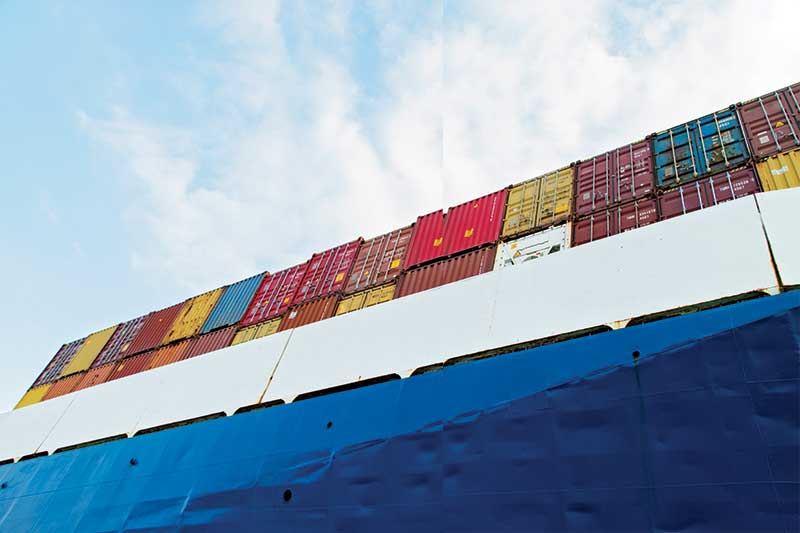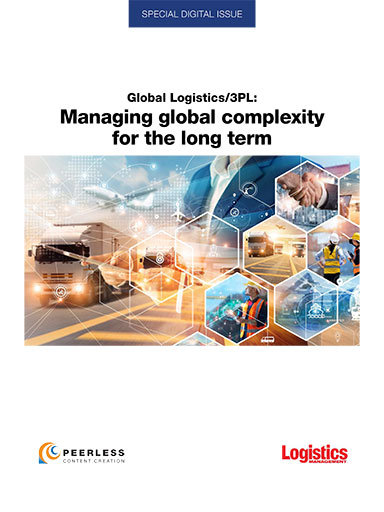2024 State of Freight Forwarders: What’s next is happening now
Technological solutions and platforms are being rapidly developed and are catapulting the freight forwarding industry into a new era. Today, the forwarding industry is undergoing a digital revolution, and analysts surmise that companies that fail to keep pace with these advancements risk falling behind—and fast.
Last year was generally downtrodden for the freight forwarding industry, with plummeting transportation rates and shippers focused on right-sizing inventories and reducing their logistics costs.
Armstrong & Armstrong (A&A) reports that the 2023 global third-party logistics (3PL) market decreased to $1.2 trillion, an 18.5% decrease compared to 2022, but still a 25.3% increase over pre-pandemic 2019.
International transportation management (ITM) 3PLs saw rapid declines in air and ocean demand and rates, while global air cargo freight rates decreased as much as 41% in the second quarter of 2023 versus the prior year. Air cargo capacity and revenues started to recover in late 2023 after 17 months of consecutive decline.
However, the airfreight forwarding market continues to be affected by soft demand. “Air freight demand remains 8% below pre-pandemic levels, and there isn’t a catalyst for faster growth on the horizon,” says Viki Keckarovska, research manager at London-based Transport Intelligence (Ti) Ltd.
So far, 2024 does not show much improvement. Industry analysts surmise the forwarding market is normalizing at new lows as a result of issues that continue to affect the industry, including volatility in the ocean freight market due to continuing uncertainty caused by political events in the Middle East, the drought in the Panama Canal, and now the situation at the Port of Baltimore; soft demand and uncertainty of the macro-economic outlook; and the immediate prospect of a significant number of new-build vessels entering the market in the second half of 2024.
Total global freight forwarder market size and growth (2013 - 2027)

Meanwhile, the industry is still feeling the effects of the surge in mergers and acquisitions. “It shows no sign of abating in 2024,” reports Sai Kiran Baliji, lead analyst of logistics research at Mordor Intelligence Analysts. With e-commerce gaining momentum and a rising influx of small and medium-sized enterprises (SMEs) entering the arena, Baliji sees the race for market supremacy primed to escalate.
Ongoing concerns
To maintain a competitive edge, analysts emphasize that forwarders must differentiate themselves and provide unparalleled value to their customers. This means addressing a host of challenges directly affecting the industry: sustainability concerns, regulations and customs complexities, and the ever-changing global supply chain—which is more fragile than ever.
The need to proactively address sustainability issues is driving forwarders toward action. They find the adoption of strategies to minimize carbon emissions in logistics operations a necessity, states Baliji.
Then there’s the labyrinth of regulations and customs complexities that vary by region and industry. “Many compliance norms mandate meticulous documentation,” says Baliji. “Ensuring efficient and secure data management is pivotal for meeting reporting and record-keeping obligations.”
Meanwhile, the global supply chain is increasingly complex, with goods being sourced from multiple countries and transported through diverse channels. “Adding to the complexity, customers are increasingly turning to nearshoring strategies, a direct response to the disruption caused by the pandemic crisis,” Baliji says.
All this adds pressure on forwarders. Transport Intelligence’s recently released State of Logistics 2024 survey found that logistics companies continue to experience pressure on margins and cite increases in operational costs and rising competition as major reasons for the increased pressure.
Research by A&A also found during the pandemic, 3PL customers realized that supply chains need to be more flexible, meaning that they need to be able to source products and components from multiple countries versus just one. Such structural shifts have made supply chains increasingly complex, which has necessitated an increasing reliance on technology to ensure high service levels.
Technology shifts
Consequently, technological solutions and platforms are rapidly being developed that are catapulting the freight forwarding industry into a new era. In fact, today, the forwarding industry is undergoing a digital revolution, and analysts surmise that companies that fail to keep pace with these advancements risk falling behind.
“In an increasingly competitive industry, freight forwarders must deploy technology to stay agile, flexible, resilient, and responsive to constantly changing circumstances,” says Evan Armstrong, president of A&A.
Ti recently found that 17.5% of freight forwarders it surveyed state that they have invested or intend to invest in data analytics in the next 12 months. “The proliferation of internet-connected devices is creating new possibilities in data gathering and analytics and freight forwarding companies appear ready to embrace the opportunities that this technology offers,” Keckarovska says.
Consequently, forwarders are increasingly implementing real-time data and analytics that facilitate seamless communication and transparency between their business and that of their clients. “This allows for better tracking of shipments, real-time updates, and personalized service offerings,” says a DB Schenker spokesperson. “Real-time visibility tools provide customers with easy-to-use online booking and quoting platforms.”
Investments are also being made in smart sensors and Internet of Things (IoT) devices that are revolutionizing inventory management by allowing real-time stock tracking for better planning and optimization, cutting costs, and ensuring product availability. “The logistics sector is experiencing a shift with drones and autonomous vehicles revolutionizing last-mile delivery, offering faster, cost-effective, and eco-friendly alternatives to traditional methods,” Baliji notes.
Tech platforms
As a result, customers are demanding faster lead times, a wider range of services, and personalized offerings from their forwarders.
“Digital platforms provide end-to-end visibility into supply chain operations, enabling proactive risk management and mitigation strategies to address disruptions caused by natural disasters, geopolitical events, or pandemics,” adds a DB Schenker spokesperson.
They also allow shippers to get online quotes, make online bookings and track their shipments. A survey by Ti Insight found that, currently, more than half of all air and sea freight bookings go through digital freight platforms. “This suggests that the adoption of digital freight platforms is rapidly taking hold across the sector,” says Keckarovska.
Almost two thirds of the freight forwarders surveyed by Ti indicated that they had invested in the development of a digital freight booking platform, with the majority having developed their platforms internally. Other tech systems coming into wider use are fleet management systems (FMS) and blockchain technology.
While FMS has been an asset for forwarders in recent years, A&A points out how its increasing is a prime example of how technology is changing the future of freight forwarding.
“FMS software uses GPS, telematics, and other information technologies to drive fleet efficiency optimization,” says Armstrong. “FMS can track valuable, actionable metrics and assist in crucial fleet management practices, and are becoming increasingly abundant and will continue to evolve to meet the industry’s demands.”
Blockchain technology is changing the future of forwarding by revolutionizing security. “Through an inherent resistance to modification of its data, as well as selective access protocols, blockchain offers new security frontiers,” Armstrong says. “Through it, forwarders can reduce previous safety costs within reason while increasing process efficiency.”
Ti ocean freight confidence index

Meanwhile, IoT and cloud-based solutions have seen wide acceptance across industries, with such notable examples as customer relationship management (CRM) software. “IoT allows for growing connected groups across the sector, multiple partners and up and down supply chains,” says Keckarovska says. “Inside organizations, the key will be having the right data presented in useful ways as the amount of available data grows massively.”
Through radio frequency identification (RFID), IoT offers effective shipment tracking across the supply chain. “Similarly, mobile-friendly cloud-based solutions such as CRM lend themselves to new industry demands and enable further consolidation of information,” says Armstrong.
While on-premise solutions remain an option, such cloud-based solutions offer a new frontier into IoT and digitization. “With smart ports already embracing such prospects, this innovative technology is changing the future of freight forwarders faced with the COVID economy,” says Armstrong. “Such digitization of ports across the globe continues to pave the way for robotic process automation, where humans and technology cooperate to improve operations across the supply chain.”
Have you invested or plan to invest in the following technologies in the next 12 months?

Similarly, artificial intelligence (AI) and advanced machine learning (ML) lend themselves to robotic process automation. From autonomous forklifts and warehouse automation to inventory management and chatbots for improved customer service, smart ports across the globe embrace digitization to the benefit of freight forwarders.
“Advanced machine learning offers freight forwarders a unique asset for data analysis,” says Armstrong. “Identifying patterns and forecasting continues to enhance resource utilization while tracking real-time performance provides actionable data to drive business decisions.”
Many of these new technologies are being driven by start-up companies. While many of these digital freight forwarders are gaining prominence, Armstrong emphasizes that they tend to focus on the “asset-light” parts of the value chain. And lack a rich asset-based background.
Consequently, many analysts expect that digital forwarders offer no threat to most large forwarders that have customer portals that aggregate huge sums of data for enhanced order and shipment visibility, improve shipment planning and inventory management, offer predictive analytics as well as standardized systems and processes.
“This helps shippers plan for supply chain disruptions and changes in carrier supply, which have been very volatile throughout the pandemic and continue today,” adds Armstrong.













